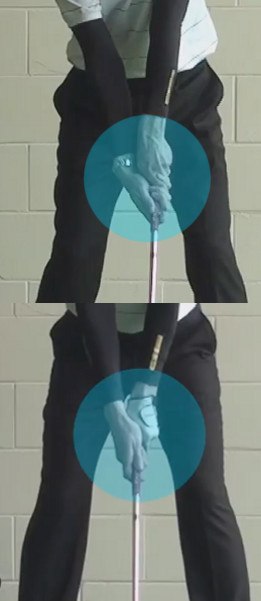You're Correct!

Youre probably happy with that answer, since a weak grip just sounds… weak. Indeed, it usually is.
The terms “neutral,” “weak” and “strong” describe the position of the hands on the handle in relation to the clubface. With a neutral grip, the palms are essentially aligned with the clubface. To illustrate, grab a ruler and hold it between flat palms. Thats a neutral grip.
A weak grip has the hands rotated to the golfers left (for a right-handed golfer). To check your position, hold a club as though setting up for a shot. If you can see one knuckle (or less) on your left hand, your grip is weak.
Naturally, a strong grip is the opposite of weak – the hands are turned to the right. The back of your left hand will show more than two knuckles. The more knuckles you can see, the more extreme the strength of your grip.
Got all that? Great. Lets move on.
Theres a reason you see very few weak grips among professional golfers (Ben Hogan and Corey Pavin being two notable exceptions): Its hard to square the clubface with a weak grip. In fact, most weak-grip players fight a slice while struggling to generate distance. The only real advantage – and the reason Hogan used a weak grip – is in making it nearly impossible to hook the ball.
So lets toss out the weak grip and focus on the best ways to hold the club.
All things being equal, gripping the club in a neutral manner makes it easiest to maintain a square clubface from start to finish. It also allows you to hit draws or fades by making small adjustments to your setup, rather than altering your swing. If youve got sound fundamentals – square address positions, good posture, consistent spine angle, etc. – a neutral grip is the way to go. Just ask Tiger Woods and Jack Nicklaus, both of whom set their hands this way.
Many golfers, however, benefit from rolling the hands toward a slightly to moderately strong grip position. For one thing, it feels natural and comfortable to most of us. A strong grip also allows the hands and arms to rotate or release more easily through the impact zone, generating added power while discouraging a slice. A strong grip enables you to play a draw as well (though youve got to guard against a hook).
Unlike the weak grip, the strong grip enjoys plentiful representation among pros. Dustin Johnson and Fred Couples are two of many noteworthy examples.
Our website is loaded with info on this all-important fundamental. Check out these tips to brush up on your grip basics:
Pros and Cons of Every Golf Grip Style
Correct Grip Pressure for More Distance
Use a Strong Grip for Powerful Release
Sorry Try Again! - See Explanation Below
Hardly. Even a tiny difference in ones grip position can make a huge difference in distance, trajectory and shot shape. If you decide a change is in order – strengthening your grip, for instance – start by shifting the hands only about 1/8”. Practice and play as much as possible to ingrain the new sensation, then move another 1/8”, if needed, once youre comfortable.
Sorry Try Again! - See Explanation Below
Hooks are bad, no doubt. But theyre much more likely to afflict pros than amateurs. Unless youve got a wicked case of the hooks and have tried other solutions – or your grip is strong in the extreme – a weaker position isnt widely recommended.
Sorry Try Again! - See Explanation Below
While its OK to adjust your grip to hit specialty shots, like a big slice or hook to escape trouble, you should hold the club the same way for every standard shot. From driver through the wedges, a consistent grip is the first step to getting steady results.







